Analyzing Solutions of Chebyshev's Equation and Polynomials
VerifiedAdded on 2023/06/06
|8
|1661
|342
Homework Assignment
AI Summary
This assignment provides detailed solutions to problems involving Chebyshev's equation and polynomial analysis. It begins by identifying regular singular points of a given differential equation and then delves into the Chebyshev polynomials, defining them and demonstrating their orthogonality. The solution further explores eigenvalue problems, deriving eigenvalues and corresponding eigenfunctions. The document also addresses non-homogeneous equations and boundary conditions. The final section discusses the transformation of a second-order differential equation and its properties. Desklib is mentioned as a resource for students seeking more solved assignments and past papers.
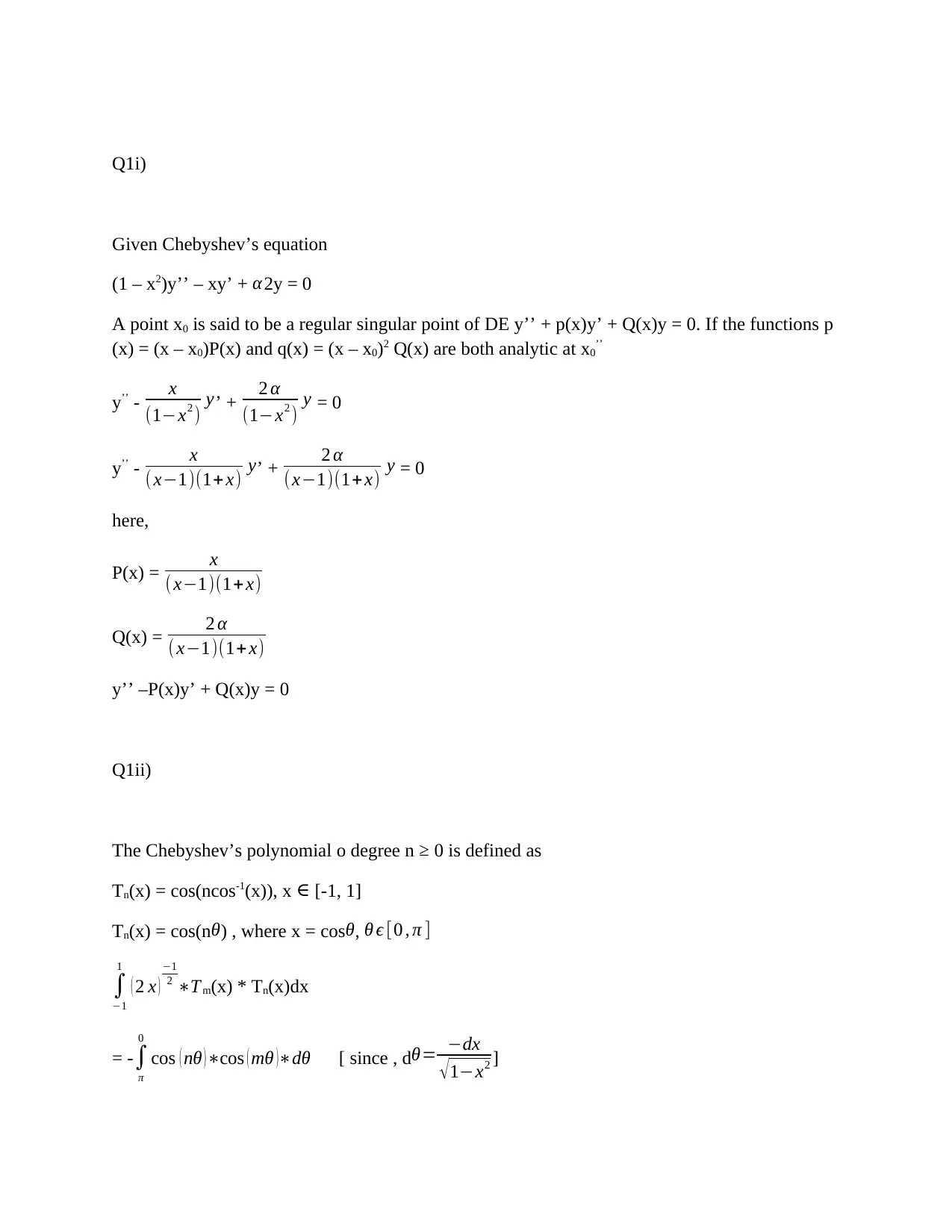
Q1i)
Given Chebyshev’s equation
(1 – x2)y’’ – xy’ + α2y = 0
A point x0 is said to be a regular singular point of DE y’’ + p(x)y’ + Q(x)y = 0. If the functions p
(x) = (x – x0)P(x) and q(x) = (x – x0)2 Q(x) are both analytic at x0’’
y’’ - x
(1−x2 ) y’ + 2 α
(1−x2 ) y = 0
y’’ - x
( x−1)(1+ x) y’ + 2 α
(x−1)(1+ x) y = 0
here,
P(x) = x
(x−1)(1+x)
Q(x) = 2 α
( x−1)(1+ x)
y’’ –P(x)y’ + Q(x)y = 0
Q1ii)
The Chebyshev’s polynomial o degree n ≥ 0 is defined as
Tn(x) = cos(ncos-1(x)), x ∈ [-1, 1]
Tn(x) = cos(nθ) , where x = cosθ, θ ϵ [0 , π ]
∫
−1
1
( 2 x )
−1
2 ∗T m(x) * Tn(x)dx
= - ∫
π
0
cos ( nθ ) ∗cos ( mθ )∗dθ [ since , dθ= −dx
√1−x2 ]
Given Chebyshev’s equation
(1 – x2)y’’ – xy’ + α2y = 0
A point x0 is said to be a regular singular point of DE y’’ + p(x)y’ + Q(x)y = 0. If the functions p
(x) = (x – x0)P(x) and q(x) = (x – x0)2 Q(x) are both analytic at x0’’
y’’ - x
(1−x2 ) y’ + 2 α
(1−x2 ) y = 0
y’’ - x
( x−1)(1+ x) y’ + 2 α
(x−1)(1+ x) y = 0
here,
P(x) = x
(x−1)(1+x)
Q(x) = 2 α
( x−1)(1+ x)
y’’ –P(x)y’ + Q(x)y = 0
Q1ii)
The Chebyshev’s polynomial o degree n ≥ 0 is defined as
Tn(x) = cos(ncos-1(x)), x ∈ [-1, 1]
Tn(x) = cos(nθ) , where x = cosθ, θ ϵ [0 , π ]
∫
−1
1
( 2 x )
−1
2 ∗T m(x) * Tn(x)dx
= - ∫
π
0
cos ( nθ ) ∗cos ( mθ )∗dθ [ since , dθ= −dx
√1−x2 ]
Paraphrase This Document
Need a fresh take? Get an instant paraphrase of this document with our AI Paraphraser
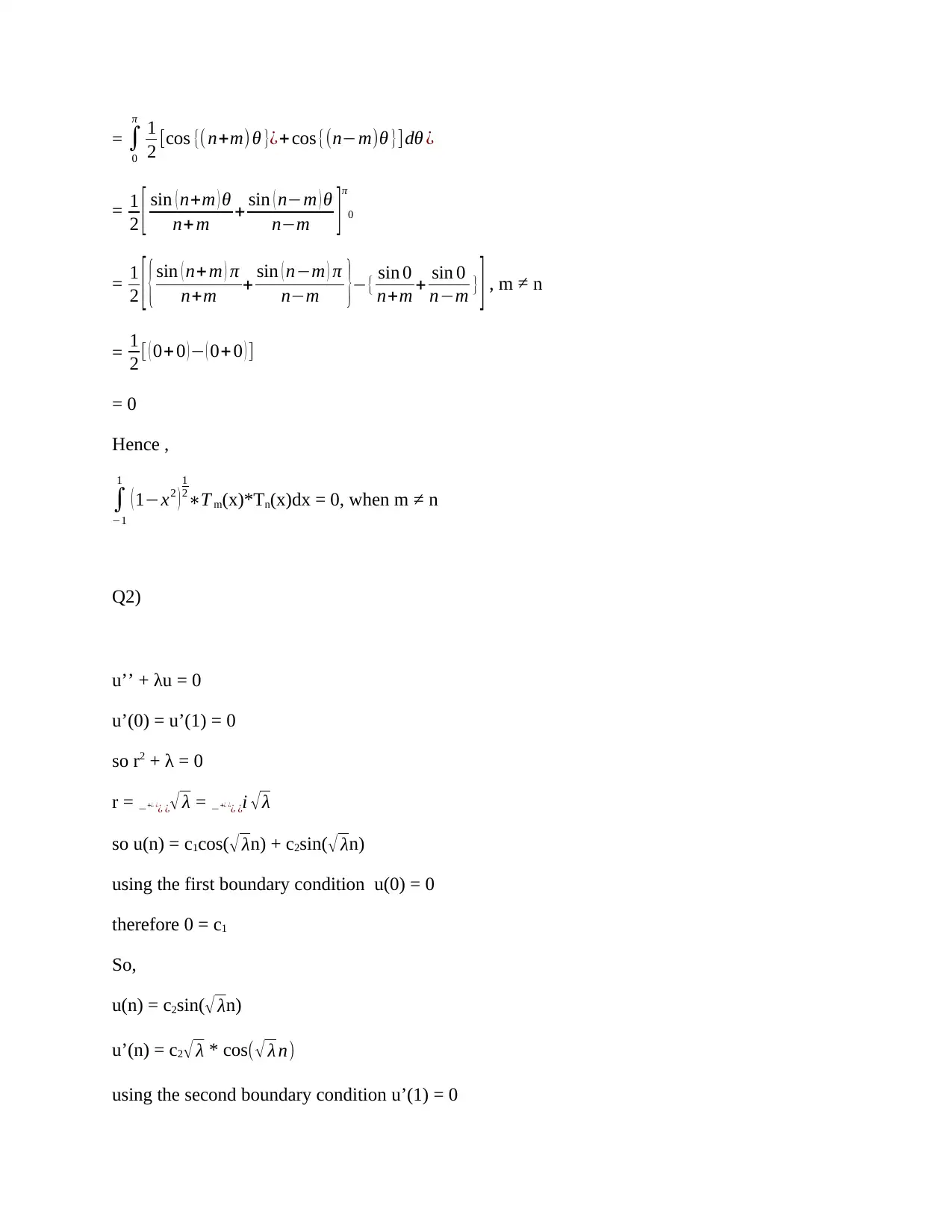
= ∫
0
π
1
2 [cos {( n+m) θ }¿+ cos {(n−m)θ }]dθ ¿
= 1
2 [ sin ( n+m ) θ
n+ m + sin ( n−m ) θ
n−m ]π
0
= 1
2 [ { sin ( n+m ) π
n+m + sin ( n−m ) π
n−m }−{ sin 0
n+m + sin 0
n−m }
] , m ≠ n
= 1
2 [ ( 0+0 )− ( 0+ 0 ) ]
= 0
Hence ,
∫
−1
1
( 1−x2 )
1
2∗T m(x)*Tn(x)dx = 0, when m ≠ n
Q2)
u’’ + λu = 0
u’(0) = u’(1) = 0
so r2 + λ = 0
r = √ λ− ¿
+¿ ¿ ¿ = i √λ− ¿
+¿ ¿ ¿
so u(n) = c1cos(√ λn) + c2sin(√ λn)
using the first boundary condition u(0) = 0
therefore 0 = c1
So,
u(n) = c2sin(√ λn)
u’(n) = c2√ λ * cos( √ λ n)
using the second boundary condition u’(1) = 0
0
π
1
2 [cos {( n+m) θ }¿+ cos {(n−m)θ }]dθ ¿
= 1
2 [ sin ( n+m ) θ
n+ m + sin ( n−m ) θ
n−m ]π
0
= 1
2 [ { sin ( n+m ) π
n+m + sin ( n−m ) π
n−m }−{ sin 0
n+m + sin 0
n−m }
] , m ≠ n
= 1
2 [ ( 0+0 )− ( 0+ 0 ) ]
= 0
Hence ,
∫
−1
1
( 1−x2 )
1
2∗T m(x)*Tn(x)dx = 0, when m ≠ n
Q2)
u’’ + λu = 0
u’(0) = u’(1) = 0
so r2 + λ = 0
r = √ λ− ¿
+¿ ¿ ¿ = i √λ− ¿
+¿ ¿ ¿
so u(n) = c1cos(√ λn) + c2sin(√ λn)
using the first boundary condition u(0) = 0
therefore 0 = c1
So,
u(n) = c2sin(√ λn)
u’(n) = c2√ λ * cos( √ λ n)
using the second boundary condition u’(1) = 0
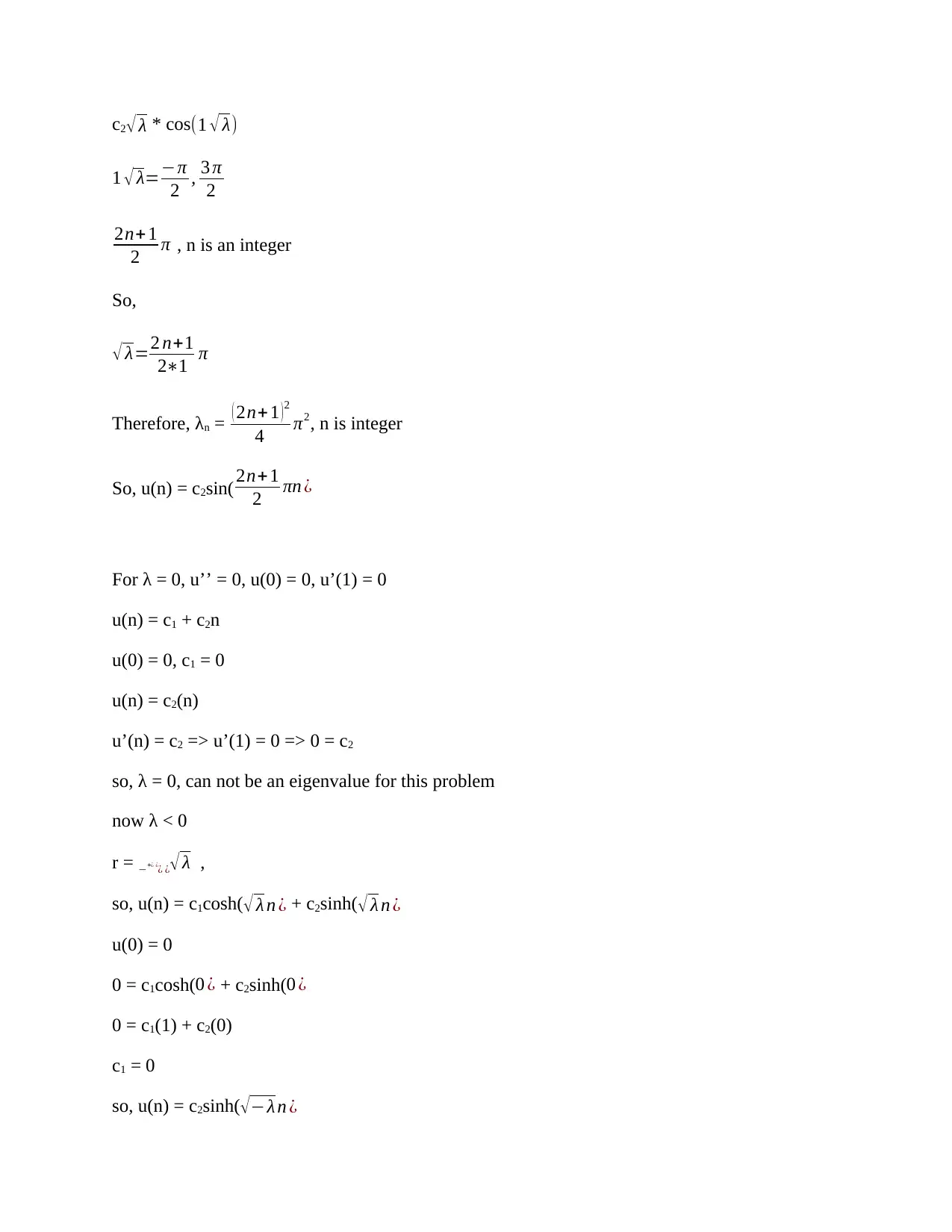
c2√ λ * cos(1 √ λ)
1 √ λ=−π
2 , 3 π
2
2n+1
2 π , n is an integer
So,
√ λ=2 n+1
2∗1 π
Therefore, λn = ( 2n+ 1 )2
4 π2, n is integer
So, u(n) = c2sin( 2n+ 1
2 πn ¿
For λ = 0, u’’ = 0, u(0) = 0, u’(1) = 0
u(n) = c1 + c2n
u(0) = 0, c1 = 0
u(n) = c2(n)
u’(n) = c2 => u’(1) = 0 => 0 = c2
so, λ = 0, can not be an eigenvalue for this problem
now λ < 0
r = √ λ− ¿
+¿ ¿ ¿ ,
so, u(n) = c1cosh(√ λ n ¿ + c2sinh(√ λ n ¿
u(0) = 0
0 = c1cosh(0 ¿ + c2sinh(0 ¿
0 = c1(1) + c2(0)
c1 = 0
so, u(n) = c2sinh(√−λ n ¿
1 √ λ=−π
2 , 3 π
2
2n+1
2 π , n is an integer
So,
√ λ=2 n+1
2∗1 π
Therefore, λn = ( 2n+ 1 )2
4 π2, n is integer
So, u(n) = c2sin( 2n+ 1
2 πn ¿
For λ = 0, u’’ = 0, u(0) = 0, u’(1) = 0
u(n) = c1 + c2n
u(0) = 0, c1 = 0
u(n) = c2(n)
u’(n) = c2 => u’(1) = 0 => 0 = c2
so, λ = 0, can not be an eigenvalue for this problem
now λ < 0
r = √ λ− ¿
+¿ ¿ ¿ ,
so, u(n) = c1cosh(√ λ n ¿ + c2sinh(√ λ n ¿
u(0) = 0
0 = c1cosh(0 ¿ + c2sinh(0 ¿
0 = c1(1) + c2(0)
c1 = 0
so, u(n) = c2sinh(√−λ n ¿
⊘ This is a preview!⊘
Do you want full access?
Subscribe today to unlock all pages.

Trusted by 1+ million students worldwide
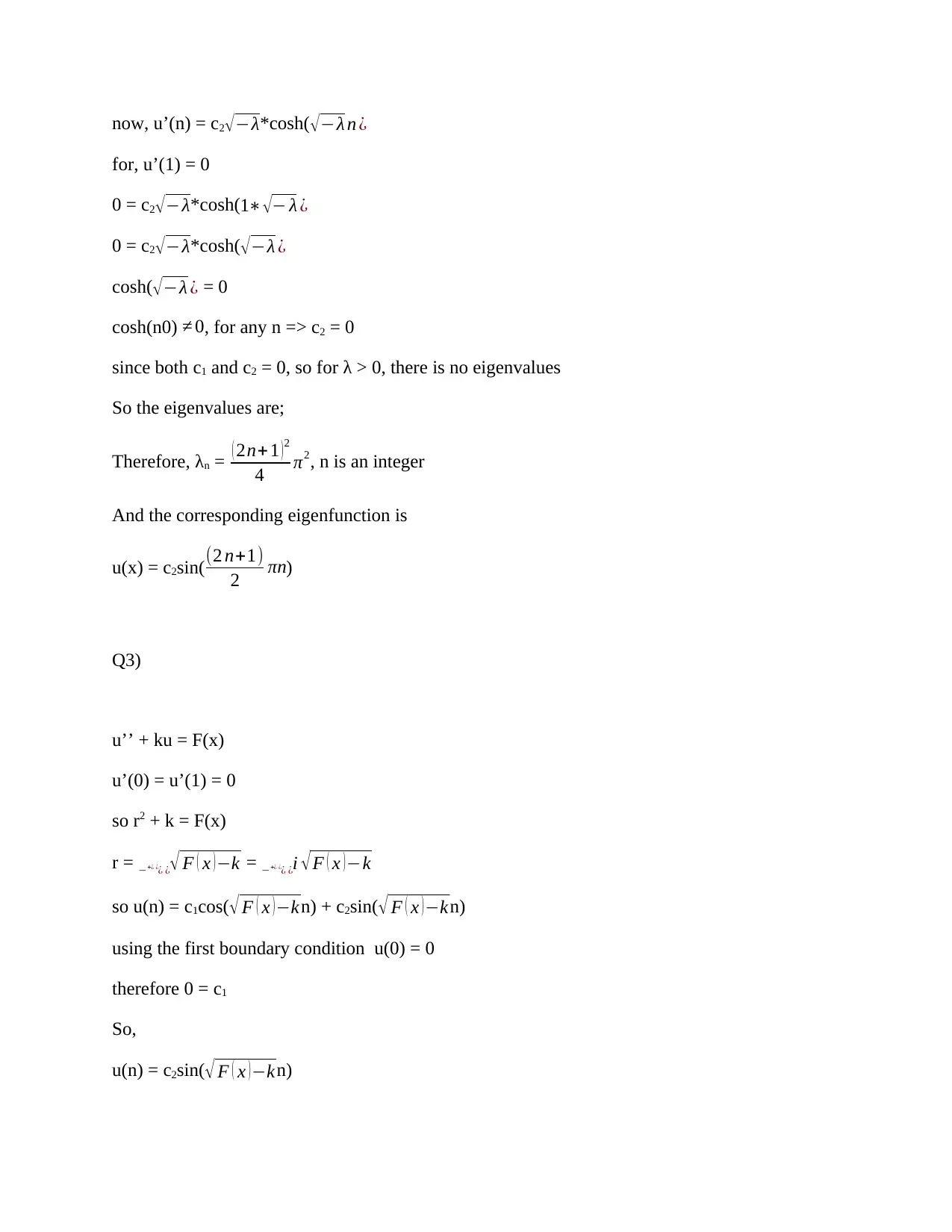
now, u’(n) = c2√−λ*cosh(√−λ n ¿
for, u’(1) = 0
0 = c2√−λ*cosh(1∗ √− λ ¿
0 = c2√−λ*cosh(√ −λ ¿
cosh(√ −λ ¿ = 0
cosh(n0) ≠ 0, for any n => c2 = 0
since both c1 and c2 = 0, so for λ > 0, there is no eigenvalues
So the eigenvalues are;
Therefore, λn = ( 2n+ 1 )2
4 π2, n is an integer
And the corresponding eigenfunction is
u(x) = c2sin( (2 n+1)
2 πn)
Q3)
u’’ + ku = F(x)
u’(0) = u’(1) = 0
so r2 + k = F(x)
r = √ F ( x ) −k− ¿+¿ ¿ ¿ = i √ F ( x ) −k− ¿+¿ ¿ ¿
so u(n) = c1cos(√ F ( x )−kn) + c2sin(√ F ( x ) −kn)
using the first boundary condition u(0) = 0
therefore 0 = c1
So,
u(n) = c2sin(√ F ( x ) −kn)
for, u’(1) = 0
0 = c2√−λ*cosh(1∗ √− λ ¿
0 = c2√−λ*cosh(√ −λ ¿
cosh(√ −λ ¿ = 0
cosh(n0) ≠ 0, for any n => c2 = 0
since both c1 and c2 = 0, so for λ > 0, there is no eigenvalues
So the eigenvalues are;
Therefore, λn = ( 2n+ 1 )2
4 π2, n is an integer
And the corresponding eigenfunction is
u(x) = c2sin( (2 n+1)
2 πn)
Q3)
u’’ + ku = F(x)
u’(0) = u’(1) = 0
so r2 + k = F(x)
r = √ F ( x ) −k− ¿+¿ ¿ ¿ = i √ F ( x ) −k− ¿+¿ ¿ ¿
so u(n) = c1cos(√ F ( x )−kn) + c2sin(√ F ( x ) −kn)
using the first boundary condition u(0) = 0
therefore 0 = c1
So,
u(n) = c2sin(√ F ( x ) −kn)
Paraphrase This Document
Need a fresh take? Get an instant paraphrase of this document with our AI Paraphraser
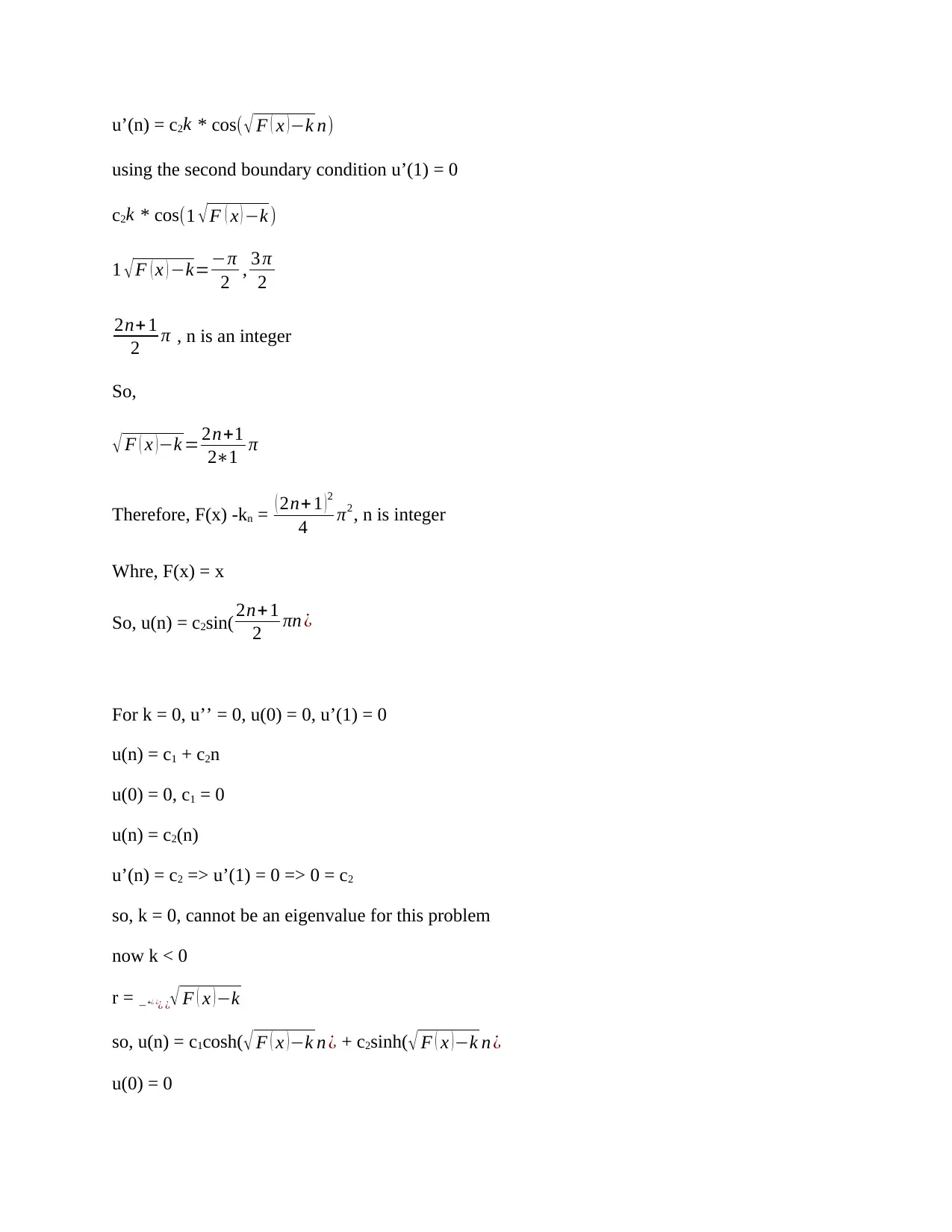
u’(n) = c2k * cos( √ F ( x )−k n)
using the second boundary condition u’(1) = 0
c2k * cos(1 √ F ( x ) −k )
1 √F ( x ) −k=−π
2 , 3 π
2
2n+1
2 π , n is an integer
So,
√ F ( x )−k = 2n+1
2∗1 π
Therefore, F(x) -kn = ( 2n+ 1 ) 2
4 π2, n is integer
Whre, F(x) = x
So, u(n) = c2sin( 2n+ 1
2 πn ¿
For k = 0, u’’ = 0, u(0) = 0, u’(1) = 0
u(n) = c1 + c2n
u(0) = 0, c1 = 0
u(n) = c2(n)
u’(n) = c2 => u’(1) = 0 => 0 = c2
so, k = 0, cannot be an eigenvalue for this problem
now k < 0
r = √ F ( x ) −k− ¿+¿ ¿ ¿
so, u(n) = c1cosh(√ F ( x )−k n ¿ + c2sinh(√ F ( x )−k n ¿
u(0) = 0
using the second boundary condition u’(1) = 0
c2k * cos(1 √ F ( x ) −k )
1 √F ( x ) −k=−π
2 , 3 π
2
2n+1
2 π , n is an integer
So,
√ F ( x )−k = 2n+1
2∗1 π
Therefore, F(x) -kn = ( 2n+ 1 ) 2
4 π2, n is integer
Whre, F(x) = x
So, u(n) = c2sin( 2n+ 1
2 πn ¿
For k = 0, u’’ = 0, u(0) = 0, u’(1) = 0
u(n) = c1 + c2n
u(0) = 0, c1 = 0
u(n) = c2(n)
u’(n) = c2 => u’(1) = 0 => 0 = c2
so, k = 0, cannot be an eigenvalue for this problem
now k < 0
r = √ F ( x ) −k− ¿+¿ ¿ ¿
so, u(n) = c1cosh(√ F ( x )−k n ¿ + c2sinh(√ F ( x )−k n ¿
u(0) = 0
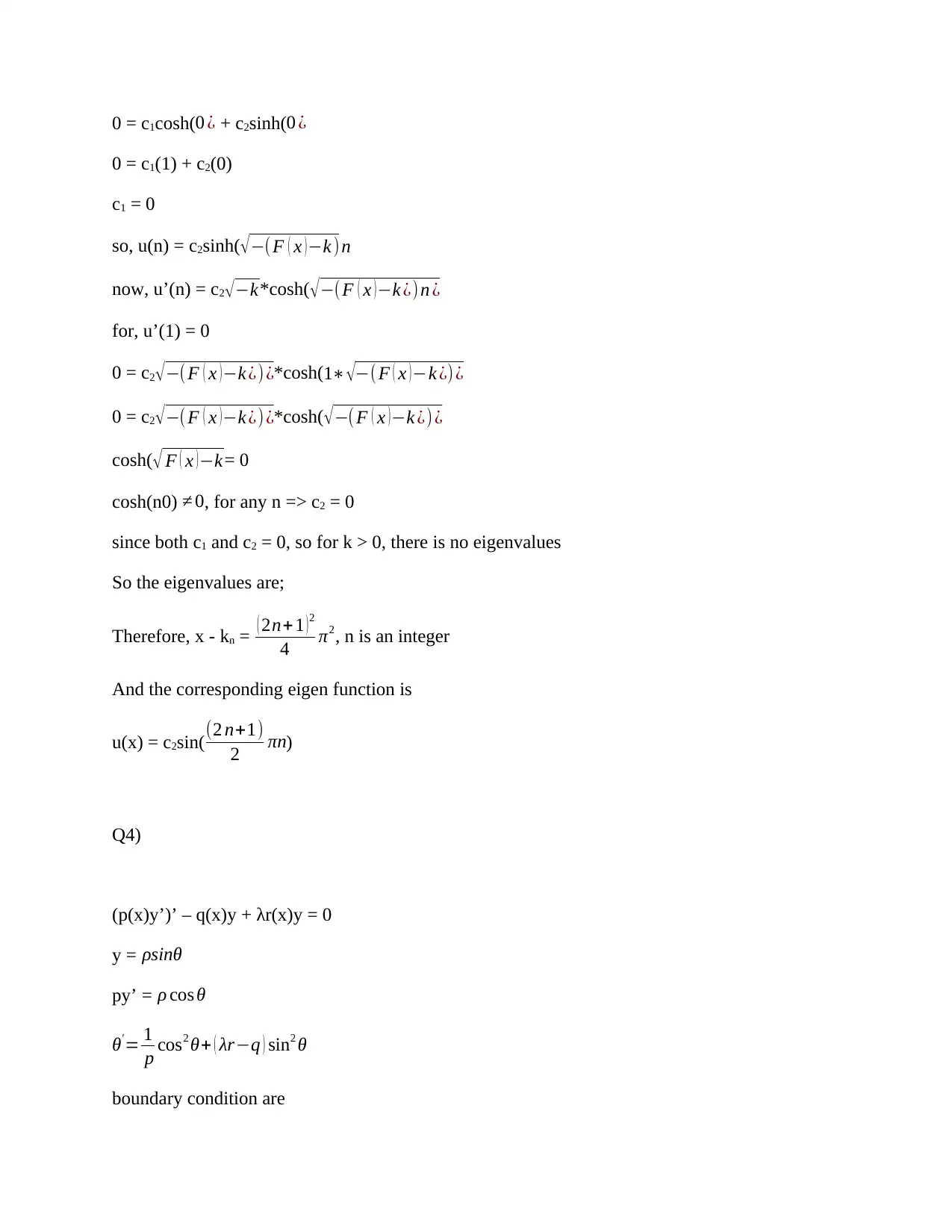
0 = c1cosh(0 ¿ + c2sinh(0 ¿
0 = c1(1) + c2(0)
c1 = 0
so, u(n) = c2sinh(√−(F ( x )−k )n
now, u’(n) = c2√ −k*cosh(√ −(F ( x ) −k ¿) n ¿
for, u’(1) = 0
0 = c2√−(F ( x )−k ¿) ¿*cosh(1∗ √−( F ( x )−k ¿) ¿
0 = c2√−(F ( x )−k ¿) ¿*cosh(√−(F ( x )−k ¿) ¿
cosh(√ F ( x ) −k= 0
cosh(n0) ≠ 0, for any n => c2 = 0
since both c1 and c2 = 0, so for k > 0, there is no eigenvalues
So the eigenvalues are;
Therefore, x - kn = ( 2n+ 1 ) 2
4 π2, n is an integer
And the corresponding eigen function is
u(x) = c2sin( (2 n+1)
2 πn)
Q4)
(p(x)y’)’ – q(x)y + λr(x)y = 0
y = ρsinθ
py’ = ρ cos θ
θ'= 1
p cos2 θ+ ( λr−q ) sin2 θ
boundary condition are
0 = c1(1) + c2(0)
c1 = 0
so, u(n) = c2sinh(√−(F ( x )−k )n
now, u’(n) = c2√ −k*cosh(√ −(F ( x ) −k ¿) n ¿
for, u’(1) = 0
0 = c2√−(F ( x )−k ¿) ¿*cosh(1∗ √−( F ( x )−k ¿) ¿
0 = c2√−(F ( x )−k ¿) ¿*cosh(√−(F ( x )−k ¿) ¿
cosh(√ F ( x ) −k= 0
cosh(n0) ≠ 0, for any n => c2 = 0
since both c1 and c2 = 0, so for k > 0, there is no eigenvalues
So the eigenvalues are;
Therefore, x - kn = ( 2n+ 1 ) 2
4 π2, n is an integer
And the corresponding eigen function is
u(x) = c2sin( (2 n+1)
2 πn)
Q4)
(p(x)y’)’ – q(x)y + λr(x)y = 0
y = ρsinθ
py’ = ρ cos θ
θ'= 1
p cos2 θ+ ( λr−q ) sin2 θ
boundary condition are
⊘ This is a preview!⊘
Do you want full access?
Subscribe today to unlock all pages.

Trusted by 1+ million students worldwide
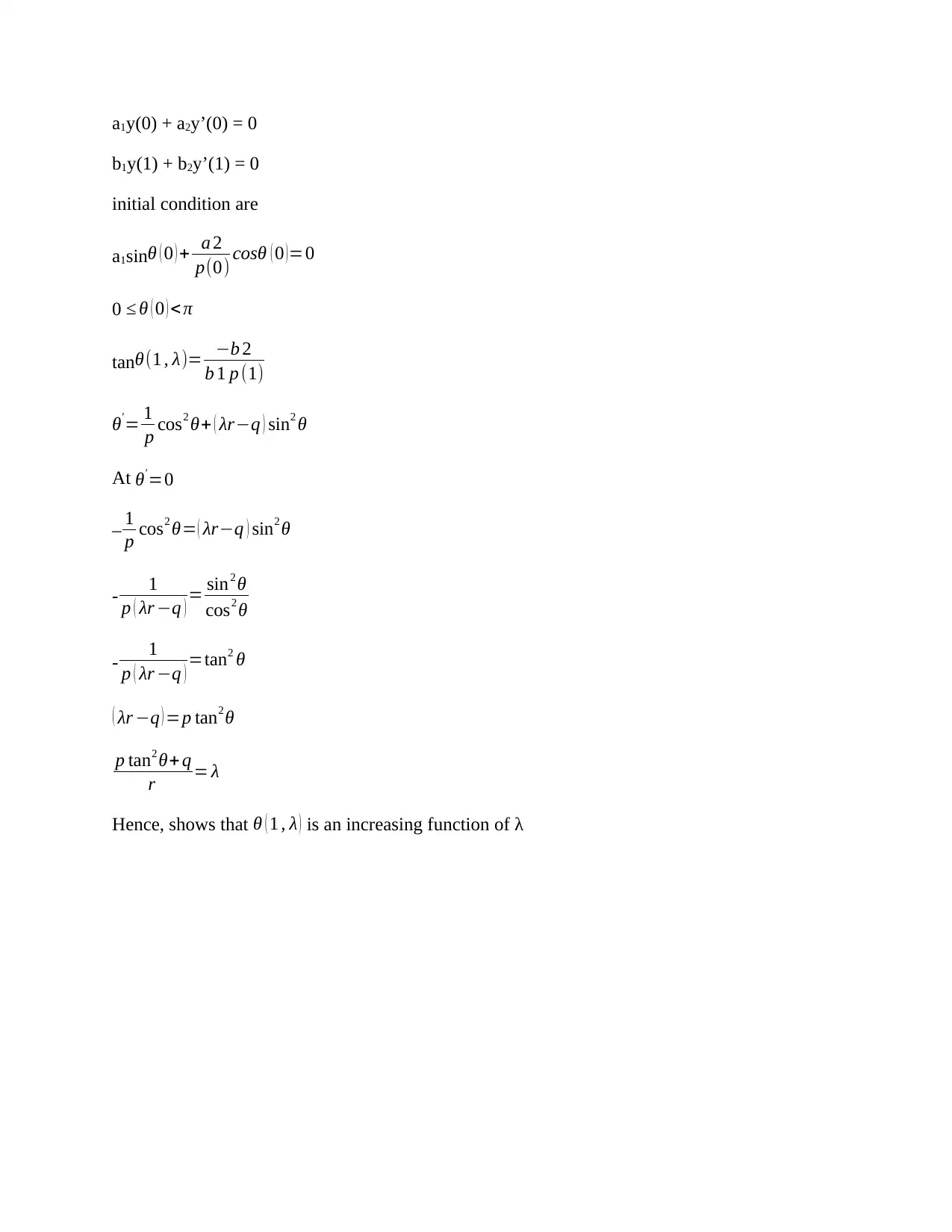
a1y(0) + a2y’(0) = 0
b1y(1) + b2y’(1) = 0
initial condition are
a1sinθ ( 0 ) + a 2
p(0) cosθ ( 0 )=0
0 ≤ θ ( 0 ) < π
tanθ(1 , λ)= −b 2
b 1 p (1)
θ'= 1
p cos2 θ+ ( λr−q ) sin2 θ
At θ'=0
– 1
p cos2 θ= ( λr−q ) sin2 θ
- 1
p ( λr −q ) = sin2 θ
cos2 θ
- 1
p ( λr −q ) =tan2 θ
( λr −q ) =p tan2 θ
p tan2 θ+ q
r = λ
Hence, shows that θ ( 1 , λ ) is an increasing function of λ
b1y(1) + b2y’(1) = 0
initial condition are
a1sinθ ( 0 ) + a 2
p(0) cosθ ( 0 )=0
0 ≤ θ ( 0 ) < π
tanθ(1 , λ)= −b 2
b 1 p (1)
θ'= 1
p cos2 θ+ ( λr−q ) sin2 θ
At θ'=0
– 1
p cos2 θ= ( λr−q ) sin2 θ
- 1
p ( λr −q ) = sin2 θ
cos2 θ
- 1
p ( λr −q ) =tan2 θ
( λr −q ) =p tan2 θ
p tan2 θ+ q
r = λ
Hence, shows that θ ( 1 , λ ) is an increasing function of λ
Paraphrase This Document
Need a fresh take? Get an instant paraphrase of this document with our AI Paraphraser

1 out of 8
Related Documents
Your All-in-One AI-Powered Toolkit for Academic Success.
+13062052269
info@desklib.com
Available 24*7 on WhatsApp / Email
![[object Object]](/_next/static/media/star-bottom.7253800d.svg)
Unlock your academic potential
Copyright © 2020–2025 A2Z Services. All Rights Reserved. Developed and managed by ZUCOL.





